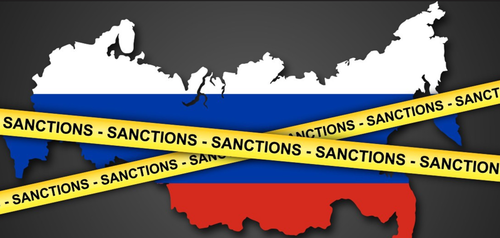US Prepares To Expand Secondary Sanctions On Russia
More than two years into the war in Eastern Europe, it’s time to ask: What have Western sanctions against Russia actually accomplished?
Earlier this year, Russian President Vladimir Putin boasted about Russia’s economic resilience and ability to withstand international sanctions. The West’s attempts to cripple Moscow’s crude oil revenues and cut off its access to military technology are failing.
Putin recently remarked, “We have growth, and they have decline… They all have problems through the roof, not even comparable to our problems.”
Given the context above, the West is about to broaden the scope of secondary sanctions on Russia, as reported by the Financial Times. This move will target any financial institution transacting with sanctioned Russian entities, treating them as working directly with Moscow’s military-industrial base.
The measure will widen a White House executive order that in December gave the Treasury the authority to apply secondary sanctions on foreign financial institutions if they were found to have acted for, or on behalf of, any of about 1,200 entities deemed by the US government to be part of Russia’s defence sector.
After this week’s change, that number will rise to more than 4,500 and will encompass almost all Russian entities that have already been sanctioned, even if this was for reasons other than direct support of the war in Ukraine. They include banks such as Sberbank and VTB, the country’s largest lenders. -FT
“Secondary sanctions are intended to expand the US’s ability to pursue circumvention by actors who do not have any legal nexus with the US. It means the US can, in effect, enforce its sanctions on people who aren’t otherwise subject to US law,” said Emily Kilcrease, a trade and sanctions expert at the Center for a New American Security think-tank.
The US aims to disrupt trade flows between Chinese institutions and Russian firms by expanding the scope of secondary sanctions. The partnership between these two nations has grown closer since the invasion of Ukraine.
Kilcrease noted, “You could see this as strengthening the legal basis under which the US could apply sanctions to Chinese banks that have assisted the Russian war effort. The Treasury will hope they take notice. But at some point you may need to actually escalate and sanction one of them.”
Meanwhile, Russian commodities firms are ramping up their use of fiat-pegged digital currencies to execute cross-border transactions with Chinese counterparts. Conducting trade in stablecoins could be problematic in the West’s attempt to crush Moscow.
As explained weeks ago by US Deputy Secretary of State Kurt Campbell in a conversation with reporters:
“I think where we are primarily focused is on Chinese companies that have been involved in a systematic way in supporting Russia . . . we’ve also looked closely at financial institutions.”
In a separate report, Reuters says the US will announce “wider sanctions on the sale of semiconductor chips and other goods to Russia, with the goal of targeting third-party sellers in China.”
“We’re going to continue to drive up costs for the Russian war machine, and this week we will announce an impactful set of new sanctions and export control actions,” National Security Council spokesman John Kirby told reporters Tuesday.
The move to broaden secondary sanctions on Russia while targeting Chinese firms comes as Group of Seven leaders plan to meet at a summit in Italy this week. One major topic to be discussed is new ways to increase aid to Ukraine and further contain Russia.
Tyler Durden
Wed, 06/12/2024 – 07:45

